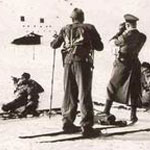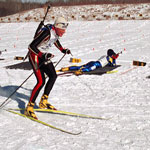What is Biathlon?
Background
Biathlon is the Olympic winter sport combining cross-country skiing rifle marksmanship. The word "biathlon" is of Greek origin and means "two tests", referring to the disciplines of cross country skiing and rifle marksmanship. The contrast in these two discplines is what creates the unique challenge of biathlon - the all out physical exersion required in cross country ski racing, and the fine control and stability needed for accurate shooting.
History

The combination of skiing and shooting used in the sport today is founded on a tradition of hunting, dating back over four thousand years. Cave drawings found throughout Norway depict hunters with spears, traveling on skis in pursuit of game. Over time, the techniques needed for survival evolved into methods of military combat, and later developed into contests of skill. The first recorded biathlon race was organized in 1767 between Swedish and Norwegian military. Used for training and defense purposes, biathlon grew in popularity among military units in Scandinavia and Central Europe, and later became known as "military patrol". Regular competitions did not take hold until the early twentieth century, when it was contested at the first Olympic Winter Games, at Chamonix, France, in 1924. The sport remained on the Olympic program until 1948, when post-war sentiments caused it to be dropped. Biathlon was re-introduced to the Olympics in 1960, with womens events added to the Olympic program in 1992.
Competition

In a biathlon competition there are classes for novice, youth, junior, senior, and master participants. Each competitor skis distances ranging from 7.5km - 20km, while carring a .22 caliber rifle on their back. The competitor stops at the shooting range either two or four times, depending on the particular event. At the range, shooting is alternated between the prone and standing position. Competitors fire five shots at metal know-down targets 50 meters away. In the prone position the targets are 45mm in diameter, or about the size of a silver dollar. The targets for the standing position are a slighly larger 115mm, or about the size of a DVD. Depending on the event, eached missed shot results in either a time penalty being added to their finish time, or a penalty loop to be skied. The winner is the competitor with the lowest elapsed time after all extra loops and time penaltys have been added.